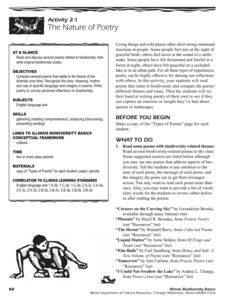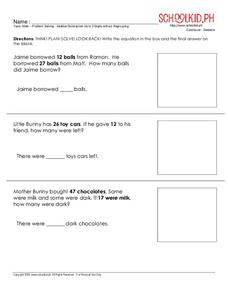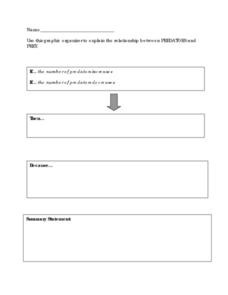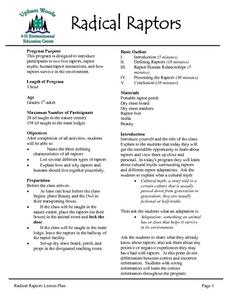Novelinks
Walk Two Moons: Story Impressions
Story chains connect literary concepts, reinforce context clues, and even help learners predict what's coming next! Using words from the next chapter of Sharon Creech's Walk Two Moons, middle schoolers craft story chains to...
Curated OER
Skulls Tell It All
Skulls tell it all, and with this lesson plan, you will tell it all to your class! Youngsters view animal skulls, analyzing the shape of teeth and the placement of the eye sockets. They associate these adaptations with the types of food...
Curated OER
Big Arky, A Real Arkansas Monster
Middle schoolers examine the world of the Arkansas alligator and topics that are related to wetland environments. They pay attention to the relationship between geography, climate, environment, and the animals who live there. A role-play...
Illinois Department of Natural Resources
Section Two: Why is Biodiversity Important?
Explore soil, genetic traits, natural resources, and pollution in a series of lessons that focus on biodiversity. Kids complete experiments to learn more about the importance of varied genes and organisms in an ecosystem.
NET Foundation for Television
1850-1874 Homestead Act Signed: The Challenges of The Plains
Start a whole new life in a land known as the Wild Wild West! Learners analyze maps, personal accounts, the Kansas-Nebraska Act, songs, and video clips to uncover life under the Homestead Act. Using their new skills, class members role...
Curated OER
Community & Architecture
Students investigate the Bamum people of Cameroon and the use of symbols in African societies. They read a handout, and design a palace using African symbols, presenting and describing their design to the class.
Curated OER
Children's Literature Across the Curriculum Ideas-Miss Spider's New Car
Students read Miss Spider's New Car by David Kirk. They complete a variety of cross-curricular activities surrounding the study of spiders. Included are reading, art, math, science, writing, social studies, and library connections.
Curated OER
Play Dough Number Sentences
First graders receive a can of play dough and form it into numbers to make addition problems. They also learn the proper format for an addition sentence from left to right. This is a great hands-on math lesson for young learners.
Curated OER
The Big Hideout
Students identify the types of camouflage used by animals in the desert. They work together to create their own animal creating their own type of camouflage. They determine how well the camouflage works.
Curated OER
Hatched From An Egg
Students discover how animals are born/hatched. In this life science lesson, students listen to a book entitled Chickens Aren't The Only Ones, and discuss animals that are hatched or born. Students receive a picture of an animal,...
Curated OER
Geography, Ecology, and Folklife
Students identify how do geography and ecology influence a region's folklife. Then they investigate this question and consider how an outsider might view their own region in this instructional activity. Students also identify how the...
Curated OER
Soil
For this soil worksheet, students read about soil and the attributes that determine how soil is formed. They then answer the 11 questions in the packet. The answers are on the last page of the packet.
Curated OER
Activity Plan 5-6: Book-Character Homes
Students use their creativity to build character homes. In this early childhood lesson plan, students develop creative-thinking, social, language, math, and motor skills as they work together to create buildings for characters from...
Curated OER
Solving Word Problems
In this finding the sums and differences for story problems worksheet, students add and subtract up to two-digits without regrouping. Students solve 6 problems.
Curated OER
Predators and Prey
Students explain how the food chain works. They contrast predators with prey and describe their function in nature. Students discuss how the food chain aids in keeping nature balanced. In small groups, they play a game that simulates the...
Curated OER
Language Arts:Similes That Make Us Smile
Students identify similes and create their own self descriptions using them as examples. After identifying characteristics associated with pictures of the sun, fish, and other items, they discover how those traits can be used as...
Curated OER
Rain Forest Similes
In this rainforest similes worksheet, 2nd graders will read two examples of similes and practice writing 5 similes about things found in the rainforest. Students will pick their favorite simile and illustrate it.
Curated OER
Problem Solving: Use a Graph: Problem Solving
In this bar graph worksheet, students read the word problem and use the bar graph to complete the problem solving questions for understand, plan, solve, and look back.
Curated OER
Characteristics of Reptiles Lesson Plan
First graders draw pictures of reptiles and share them with the class describing the characteristics of the reptile. In this reptiles lesson plan, 1st graders determine if animals in pictures are reptiles or not.
Curated OER
What's Up at the Rim?
Students are sent on a scavenger hunt to find as many plants as they can in nature.
Curated OER
Social Studies: Classroom Culture
Sixth graders compose a list of classroom cultural values. They begin with a list of unacceptable behaviors. Each student presents two ideas they think should be part of the class culture. Students try to persuade classmates to accept...
Curated OER
Mini-Ecosystems
Third graders identify the living and non living things in a book read aloud and discuss the interactions represented in the book. Then, they research and include a list of food that each animal needs in an ecosystem. Finally, 3rd...
Curated OER
Radical Raptors
Young scholars are introduced to raptors and their role in the environment. They identify three characteristics of raptors and list several types of raptors found in nature. They discuss their positive and negative experiences with...
Curated OER
Total English Advanced: Animals and Their Environment Crossword!
In this key vocabulary crossword puzzle worksheet, learners practice key vocabulary as they read the 14 clues to correctly fill in the word puzzle.

























